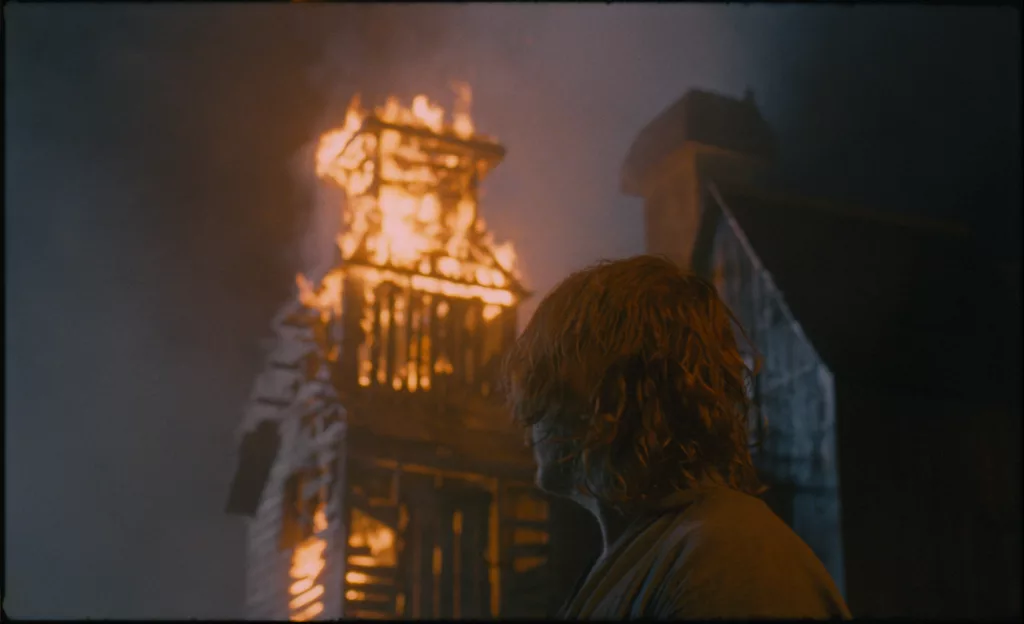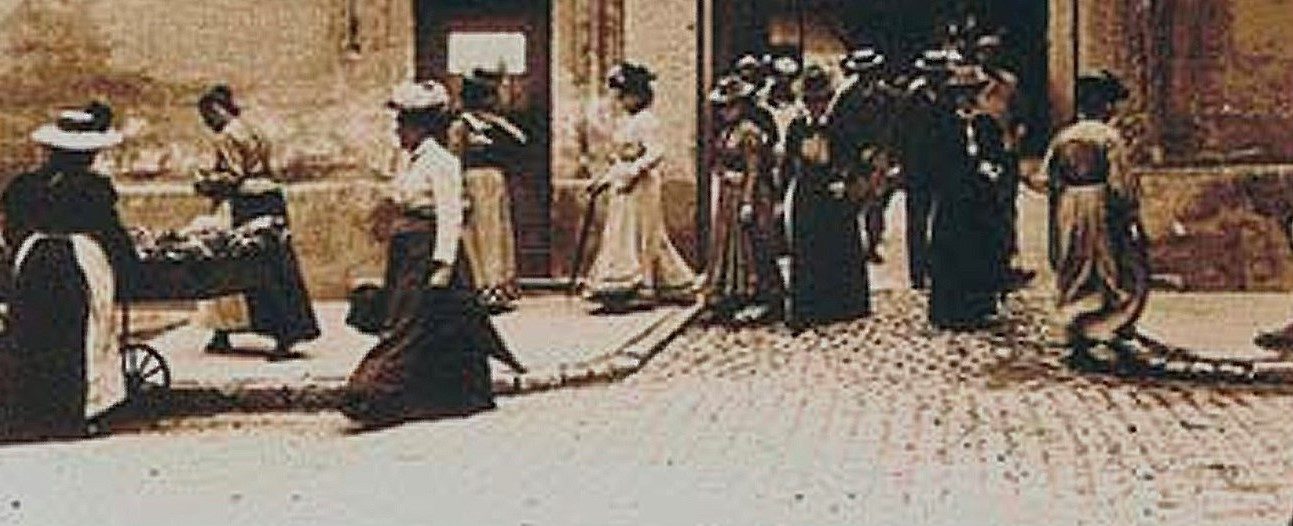United Kingdom, Greece, France, Germany, United States, 2024
Directed by Athina Rachel Tsangari
With Caleb Landry Jones (Walter Thirsk), Harry Melling (Master Kent), Frank Dillane (Master Jordan), Arinzé Kene (Philip “Quill” Earle), Thalissa Teixeira (Mistress Beldam), Noor Dillan-Night (Younger Beldam), Gary Maitland (Older Bedlam), Rosy McEwen (Kitty Gosse)

Although disconcerting the first images prove essential by conveying sensuality and tactility in so raw and deep visual terms. The disheveled man hopping from one place to another of an endless meadow, putting childishly his fingers into the dirt and the holes, biting ravenously barks and mosses, skin-dipping cheerfully in the nearby lake till dark, may look crazy, springing out, behaving so savagely, with nothing hinting at a specific era and area to help the audience grasp what is going on. But they can still be touched, riveted, by a peculiar cinematography, a kind of golden light looking both delicately natural and yet a bit enhanced and an equally appealing but slightly hard to define texture suiting well the immediacy and the grace of the countryside the mobile camera has explored in detail or with some distance tracking the queer young guy.
This is his land – precisely, this is the earth he is attached to and wants to stay on, the world exclusively and affectionately known to him, the only one he cares about till the bitter end. “Harvest” is the story of a bond the lead character, Walter Thirsk, cherishes and cannot imagine vanishing, even though he is forced to cope with changes and dramas that in a few days do destroy this world.
He was not quite the manner born, however. In later conversations he hints his parents were from another background, and then explains he used to be his master’s manservant after being raised with him but chose out of love for a pretty girl living on his master’s manor to become a mere peasant. The woman, alas, died early, but Walter Thirsk has remained among the villagers and kept toiling the land. He has remained a bachelor, even if he has an affair with Kitty Gosse, one of the most energetic and assertive women of the village attached to the Master Kent’s demesne, and is still viewed as a bit peculiar and not really a genuine peasant because of that special bond to Master Kent. But his love for and loyalty to the land are obvious.
His tragic story begins as the time for harvest comes close to end and the inhabitants of that very remote corner of England look forward to enjoying a hard-earned day of rest and feasting, according to tradition, at their landowner’s table. But their cheerful anticipation is swiftly replaced with alarm and suspicion. First an arson damages the shed where Master Kent breeds birds and it is quite unclear who did took and ate them, with the land of the manor upset that someone from the little community he heads, or rather as he sees it, of the family he leads, could have done such a thing. Then smoke rises from the wooded edge of the village, threatening widespread destruction. This time, suspects can be right away found and caught. Those Beldam fellows claim they are innocent, but the two men, one older than the other, both equally nasty and snarky, are pilloried, their punishment set to last a whole week, while the woman who was with them, the Mistress Beldam, is humbled but set free, which turns out fast as a reckless show of leniency from Master Kent.
But two other events cause further upset and fear among the villagers and they have nothing to do with them or other country folks. First they notice a strange Black man with canvases and brushes drawing near them. He is Philip “Quill” Earle, a professional map maker hired by Master Kent to chart his manor’s lands. Then they watch with even more surprise the arrival a cousin of the dead wife of their lord. He is Master Jordan, who is claiming inheritance rights and has strong ideas on how to manage and to squeeze a profit from the fields of the widow of his cousin. The maps drawn by Philip “Quill” Earle are the first tools he intents to use to assert his rights and his authority. Other tools, far more brutal and problematic, are soon to be used against the villagers.
Walter Thirsk has been invited to work with Quill by Master Kent. The professional relation, however, gets more friendly, to the displeasure of the villagers. Things get sour once Quill explains what is going to happen to the village and the manor. As Mistress Beldam, in a witchy way, causes troubles, the villagers get more confused and more infuriated, and Master Jordan and his dubious servants exert their power and carry out their plans with increasing brutality, Walter Thirsk ends up on his own, powerless and distrusted, doomed to watch his master leaving his land and this land turned into a wasteland waiting for a new economy to thrive in lieu of the ancient ways of living and working.
Unfolding without a clear date – clothes and habits suggest this is the very end of the Middle Ages but it could also be quite later, with language mixing modern words and ways with older ones from various registers – the story relates a widely-known and highly important historical development, the long process of enclosing common land and alter manor lands in order to create new private properties pursuing a more capitalistic agriculture. Enclosure started in the 12th century and ended in the 18th century, forever changing Britain, if only because the system allowed the intensive breeding of sheep and a strong textile industry and deprived poor peasants of harvests, wood, and food they were permitted to pick up for themselves. The change was hugely profitable for the landlords – this is precisely what Master Jordan spells out and expects – and truly terrible for the peasants – and the exodus of the villagers Walter Thirsk so miserably fails to stop at the end is the obvious example, reenacting in fact what the Beldams have themselves experienced.
Avoiding pointedly to look like a run-of-the-mill period piece, delving gladly into folk rural culture – witness the feast and the bonfire dancing and singing – and even flirting with the folk horror genre – witness the hallucinations of Walter Thirsk and how some incidents are staged in a way that purposefully disturbs and suggests something more wicked and supernatural is working – the film deftly emphasizes the gap between an approach to the world based on tactility and familiarity and a more modern but more antagonistic one based on more rationalized and abstract views.
Walter Thirsk until the very end keeps trying to be one with the land, stubbornly working the dirt, sowing seeds, hitting the stones that mark the limits of the manor to acknowledge both these limits and his belonging to the manor. At the same time he would bitterly blame Quill for what is destroying his world, reproaching him from flattening it in the maps or would try to keep his best friend to leave the place by warning him that in towns he and his kin would be unknown while in the manor they are known, they have a name other recognize but a name that would get lost in the faraway streets.
This is why “Harvest” is such an interesting film. Adapting a Jim Crace novel, it bears witness to an essential transformation that is also an intense tragedy through a meandering but increasingly unsettling narrative, whose pace may be uneven but whose cinematography consistently alluring and evocative. It is the painful end of a known world to the benefit of a new economic system and the heartbreaking and chaotic fall from grace of a man who thought there were bonds that cannot be unbound but still are set to.

